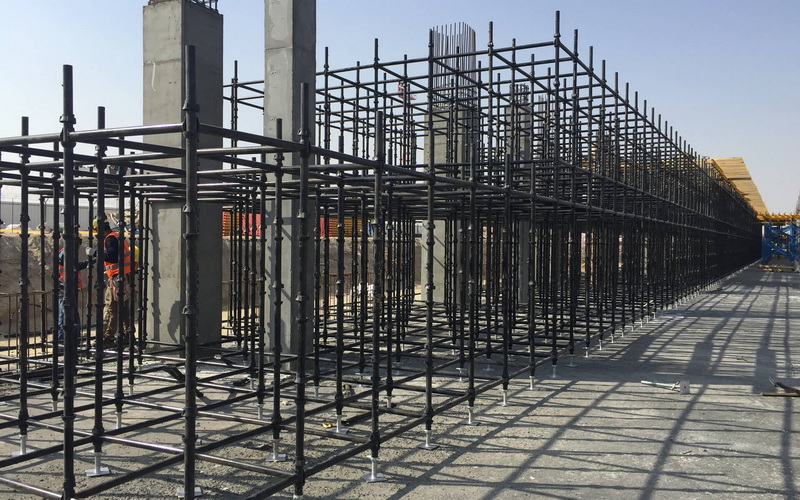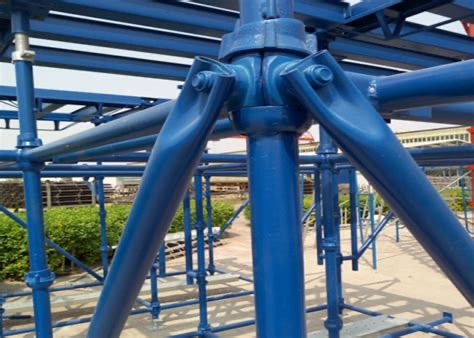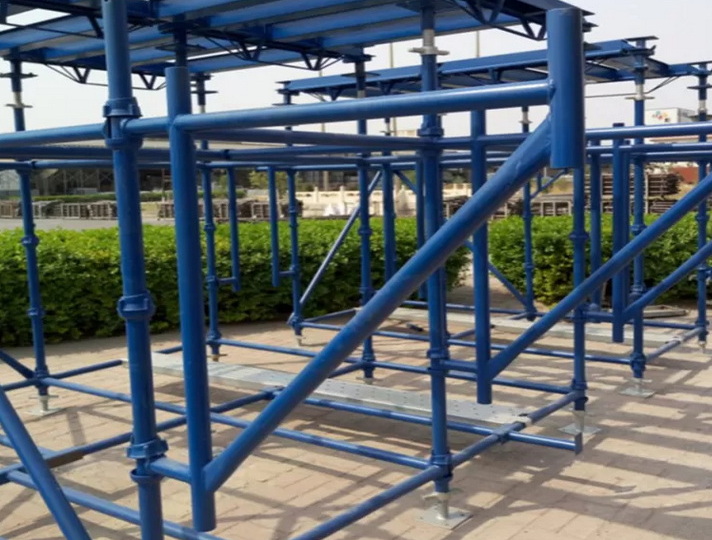Content Menu
● Introduction to Cup Lock System Scaffolding
● Key Features of Cup Lock System Scaffolding
● Steps to Install Cup Lock System Scaffolding Efficiently
>> 1. Pre-Installation Planning
>> 2. Assembly Process
>> 3. Safety Features
● Safety Considerations for Cup Lock System Scaffolding
● Case Studies: Successful Use of Cup Lock System Scaffolding
>> 1. High-Rise Construction
>> 2. Bridge Construction
● Comparison with Other Scaffolding Systems
● Additional Accessories for Cup Lock System Scaffolding
>> 1. Hop-Up Brackets
>> 2. Return Devices
● Conclusion
● FAQ
>> 1. What are the primary benefits of using cup lock system scaffolding?
>> 2. How does the cup lock system differ from traditional scaffolding systems?
>> 3. What safety features does cup lock system scaffolding provide?
>> 4. Can cup lock system scaffolding be used for projects other than high-rise construction?
>> 5. How does cup lock system scaffolding contribute to cost savings?
● Citations:
Installing cup lock system scaffolding efficiently requires careful planning, proper training, and adherence to safety guidelines. The cup lock system, known for its versatility and ease of assembly, is widely used in construction projects due to its modular design and robust construction. This article will guide you through the process of installing cup lock system scaffolding efficiently, highlighting key steps and safety considerations.

Introduction to Cup Lock System Scaffolding
Cup lock system scaffolding is a popular choice in the construction industry due to its simplicity and speed of assembly. It uses a unique node-point locking device that allows up to four horizontal ledgers to be connected to a single vertical standard, making it one of the fastest and safest scaffolding systems available.
Key Features of Cup Lock System Scaffolding
1. Efficient Assembly: The cup lock mechanism allows for quick connections without the need for loose bolts, wedges, or clips.
2. Robust Construction: Made from high-grade galvanized steel, the system is durable and resistant to corrosion.
3. Versatility: Suitable for various construction applications, including facade, shoring structures, circular structures, and more.
Steps to Install Cup Lock System Scaffolding Efficiently
1. Pre-Installation Planning
- Site Assessment: Evaluate the site conditions to determine the appropriate scaffolding configuration.
- Load Calculations: Ensure the scaffolding can support the weight of workers, equipment, and materials.
2. Assembly Process
1. Base Preparation: Ensure the ground is level and stable. Use base jacks to adjust the height if necessary.
2. Vertical Standards: Install the vertical standards, ensuring they are securely positioned and levelled.
3. Ledger Installation: Attach ledgers to the vertical standards using the cup lock mechanism. Each ledger blade is hooked into the lower fixed cup, and the movable cup is pushed onto the upper hook and tightened with a hammer blow.
4. Transom Installation: Add transoms to provide intermediate support for the scaffold walkboards.
5. Bracing: Install diagonal bracing to enhance stability and prevent sway.
3. Safety Features
- Guardrails: Install guardrails and toeboards to prevent falls.
- Regular Inspections: Conduct regular checks for damage or wear.
- Proper Training: Ensure all workers are trained in assembly, use, and dismantling procedures.

Safety Considerations for Cup Lock System Scaffolding
Safety is paramount when using cup lock system scaffolding. Key considerations include:
- Compliance with Standards: Ensure the system meets local safety standards and regulations, such as BS EN 12811 and 12810.
- Proper Assembly: Ensure all components are securely connected using the cup lock mechanism.
- Fall Protection: Implement fall protection measures such as guardrails and safety nets.
Case Studies: Successful Use of Cup Lock System Scaffolding
1. High-Rise Construction
Cup lock system scaffolding has been successfully used in high-rise construction projects due to its robust construction and ease of assembly. It provides a stable working platform for workers, enhancing safety and efficiency.
2. Bridge Construction
In bridge construction, the cup lock system is used for its versatility and ability to support heavy loads. It allows for the creation of complex scaffolding configurations, making it ideal for large-scale projects.
Comparison with Other Scaffolding Systems
| Feature | Cup Lock System Scaffolding | Traditional Scaffolding |
| Assembly Speed | Fast, modular design | Slower, more labor-intensive |
| Load Capacity | High, suitable for heavy-duty projects | Generally lower |
| Adaptability | Highly adaptable to complex structures | Limited adaptability |
| Safety Features | Stable structure, compliance with standards | Basic safety features |
Additional Accessories for Cup Lock System Scaffolding
1. Hop-Up Brackets
Hop-up brackets are used to increase the width of the working platform, supporting additional boards beyond the inner face of the scaffold. They incorporate a cup joint for linking with inside ledgers.
2. Return Devices
Return devices are used in pairs to connect adjacent scaffolds, enhancing stability and providing a secure working environment.
Conclusion
Installing cup lock system scaffolding efficiently requires careful planning, proper training, and adherence to safety guidelines. The system's unique locking mechanism and robust construction make it an ideal choice for various construction projects. By following the steps outlined in this article, contractors can enhance project productivity while ensuring a secure working environment.

FAQ
1. What are the primary benefits of using cup lock system scaffolding?
The primary benefits include rapid assembly, high load-bearing capacity, and versatility. The cup lock system provides a stable working platform, reducing labor costs and enhancing worker safety.
2. How does the cup lock system differ from traditional scaffolding systems?
Cup lock system scaffolding is distinguished by its unique locking mechanism, allowing for quick connections without loose bolts or wedges. It offers higher load capacity and adaptability compared to traditional systems.
3. What safety features does cup lock system scaffolding provide?
The cup lock system provides a stable structure that complies with international safety standards. Regular inspections and proper assembly are crucial for maintaining safety.
4. Can cup lock system scaffolding be used for projects other than high-rise construction?
Yes, cup lock system scaffolding is suitable for a wide range of projects, including bridge construction, facade work, and shoring structures. Its versatility makes it adaptable to various construction scenarios.
5. How does cup lock system scaffolding contribute to cost savings?
Cup lock system scaffolding contributes to cost savings by reducing labor costs through efficient assembly and disassembly. Its durable materials also ensure long-term usability, minimizing replacement costs.
Citations:
[1] https://www.affixscaffolding.com/wp-content/uploads/2022/03/Affix-Cuplock-Manual.pdf
[2] https://www.internationalscaffolding.com/projects/what-is-a-cuplock-scaffolding-system/
[3] https://scaffco.com/wp-content/uploads/2020/04/07-Cuplock-System.pdf
[4] https://www.scafom-rux.com/en/scaffolding-blog/beginner-s-guide-to-scaffolding-types-the-cuplock-modular-scaffold
[5] https://www.scaffoldmfg.com/enhancing-construction-safety-with-the-cuplock-scaffolding-system/
[6] https://www.osha.gov/sites/default/files/publications/OSHA_FS-3759.pdf
[7] https://scaffolding-solutions.com.cy/wp-content/uploads/2022/06/user_manual_cuplok_10-2006.pdf
[8] https://rapid-scafform.com/cuplock-scaffold/
[9] https://www.huennebeck.com/uploads/files/cuplok_system_scaffold_user_guide_en_2015-05-29.pdf






















